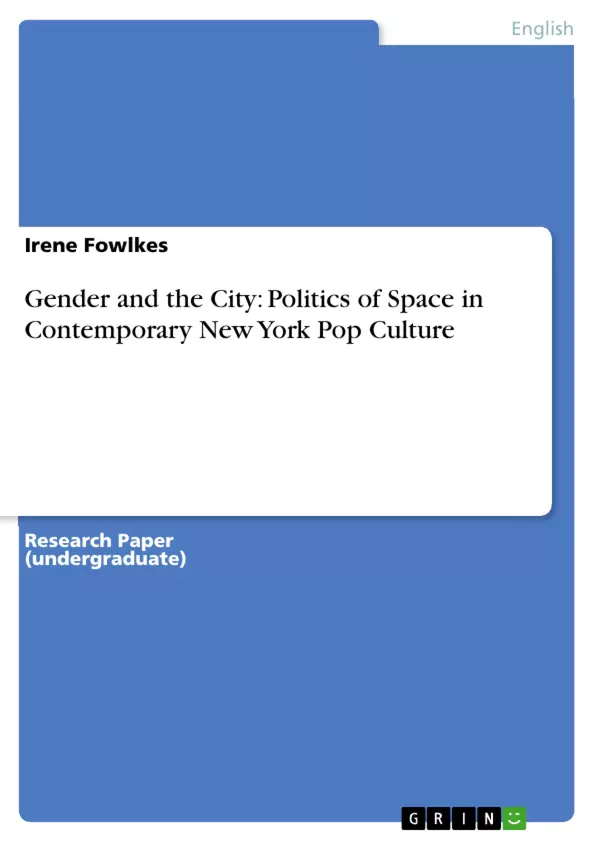A kaleidoscope of New York City in terms of gender is created through an elaborate scholarly investigation as contemporary popular forms are considered across various media. By analysis of spatial categories, it explores the post 9/11 imagination of the metropolis in light of an inherent logic of consumer culture with a focus on women's views. Shaping an awareness of female voices as arguably characteristic of the postmodern cityscape, the essay aims to serve as an impulse in support of new ideas in feminist urban art politics.
Inhaltsverzeichnis (Table of Contents)
- Introduction: New York City Topographies in Contemporary Pop Culture...
- City as Text: From Baudrillard's Graffiti Essay to current Trends in Urban Theory...
- City as Theme: From Babylon to New York City - Cultural History of the Metropolis...
- Money, Power, Respect: New Inscriptions of Femininity into the Urban Landscape in Candace Bushnell's Lipstick Jungle and One Fifth Avenue...
- The Dark Side of the City: Psychology of the Female Mind and changing Topographies in Neil Jordan's The Brave One...
- From the Streets of the Bronx to Mainstream Music: Short History of Rap...
- New York State of Mind: Topographic Narratives in Contemporary Hip Hop music.. [Empire State of Mind (Jay Z featuring Alicia Keys), I love New York (Madonna), American Boy (Estelle featuring Kanye West), Pacifics (Digable Planets)]
- City of Dreams: Old Visions and New Perspectives of the City in the Visual Arts... [Times Square (Knud Hoi), Skyway over Manhattan (Jacques Olivar), Legends 4 (Gery Uger), New York City by Light (N. Cherikov), New York 02 (H.G. Esch)]
Zielsetzung und Themenschwerpunkte (Objectives and Key Themes)
This research aims to investigate how contemporary popular culture in New York City reflects and shapes the city's topographies, specifically focusing on the experiences of women. The analysis explores how gender and ethnicity contribute to the city's imagination and how this understanding evolved in a post 9/11 world.
- The interplay of gender, ethnicity, and space in contemporary New York City popular culture.
- The city as a text and its representation in various media, including literature, film, music, and visual art.
- The evolution of urban theory and its application to understanding contemporary New York City.
- The influence of consumer culture and postmodernity on the urban landscape.
- The role of women in shaping the city's identity and how their experiences are reflected in pop culture.
Zusammenfassung der Kapitel (Chapter Summaries)
- Introduction: This chapter sets the stage for the research, introducing the concept of New York City as a cultural and social center and its importance in contemporary pop culture. It highlights the influence of the 9/11 attacks and the enduring significance of the city's urban environment. The introduction also emphasizes the need to consider gender and ethnicity when exploring urban spaces.
- City as Text: This chapter explores the city as a text, drawing from Baudrillard's analysis of Graffiti and the broader trends in urban theory. It examines how the urban landscape is constructed and interpreted through various cultural practices and how these interpretations have evolved over time.
- City as Theme: This chapter traces the historical development of the city as a theme in cultural history, comparing New York City to Babylon and Rome. It also explores the unique perspective of the city in African-American thought, particularly in relation to its role as a place of deliverance from the rural South.
- Money, Power, Respect: This chapter analyzes Candace Bushnell's novels Lipstick Jungle and One Fifth Avenue, focusing on how they portray women's experiences in elite New York City circles. It investigates how these novels use space to depict social status, power dynamics, and gendered experiences.
- The Dark Side of the City: This chapter examines Neil Jordan's film The Brave One, exploring how the main character's psychological state influences her perception of the city. It delves into the film's portrayal of the city's darker aspects and the shifting topographies of the urban environment.
- From the Streets of the Bronx to Mainstream Music: This chapter provides a brief history of rap music, focusing on its development from a subculture to a mainstream genre. It also examines how contemporary hip hop music uses the city as a source of narrative and how it reflects on its specific locations and socio-cultural contexts.
Schlüsselwörter (Keywords)
The research focuses on contemporary New York City popular culture, gendered space, urban theory, consumer culture, postmodernity, hip hop music, visual art, literature, film, and the impact of the 9/11 attacks on urban landscapes.
- Citar trabajo
- Irene Fowlkes (Autor), 2010, Gender and the City: Politics of Space in Contemporary New York Pop Culture, Múnich, GRIN Verlag, https://www.grin.com/document/165160



